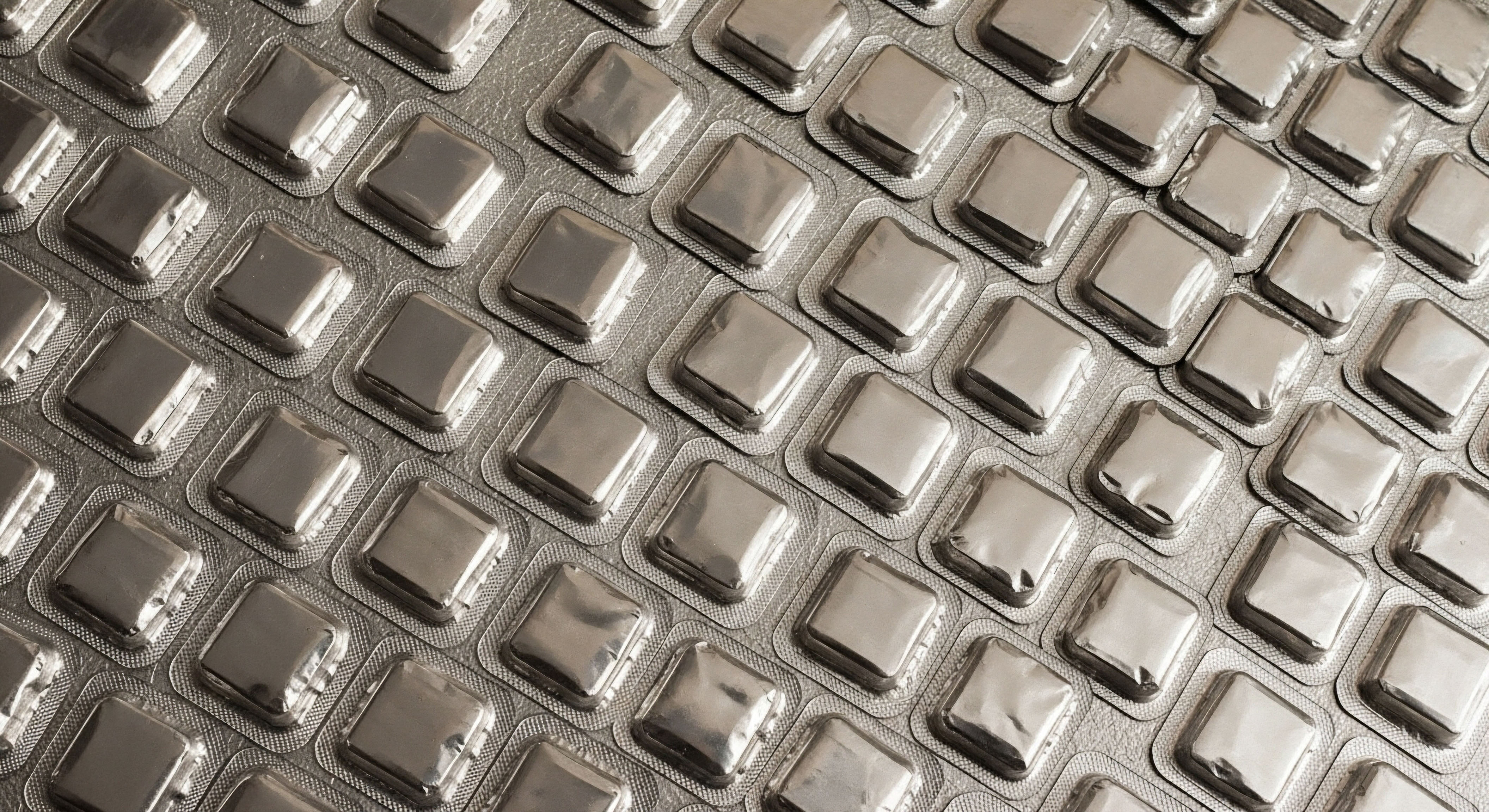

Fundamentals
The decision to consider stepping away from a hormonal support protocol like Testosterone Replacement Therapy (TRT) and its companion, Gonadorelin, originates from a deeply personal place. It represents a significant point in your health timeline, a moment of re-evaluation.
You have gathered data on how your body responds to external hormonal signals, and now you are contemplating a transition. This process is a deliberate act of biological negotiation, a conversation with your endocrine system about its readiness to resume its own cadence. Your body has been operating with external instructions, and the path forward involves methodically encouraging its own internal communication network to come back online.
Understanding this journey begins with appreciating the elegant, yet powerful, system at its core ∞ the Hypothalamic-Pituitary-Gonadal (HPG) axis. Think of this as your body’s internal command structure for reproductive and metabolic health. The hypothalamus, a small region in your brain, acts as the mission commander.
It sends out a specific, rhythmic signal called Gonadotropin-Releasing Hormone (GnRH). This signal travels a short distance to the pituitary gland, the field general. Upon receiving the GnRH signal, the pituitary dispatches two messengers into the bloodstream ∞ Luteinizing Hormone (LH) and Follicle-Stimulating Hormone (FSH). These messengers travel to the gonads, the specialized operational units. In men, LH instructs the Leydig cells within the testes to produce testosterone, while FSH is primarily involved in supporting sperm production.
When you are on TRT, your body detects sufficient testosterone from an external source. This abundance of testosterone sends a powerful feedback message back to the hypothalamus and pituitary. The message is clear ∞ “Production targets are met; stand down.” In response, the hypothalamus reduces or ceases its GnRH pulses, and consequently, the pituitary stops sending LH and FSH signals.
The testicular production line, receiving no new orders, becomes dormant. This is a highly efficient and normal physiological response. The system is designed to conserve resources when a hormone is plentiful.

Recalibrating the System
The process of discontinuing TRT is the process of reversing this sequence. It involves removing the external testosterone signal and then systematically encouraging each part of the HPG axis to resume its duties. This is where the considerations become deeply practical. The system does not simply switch back on.
The command centers in the brain need to recognize the absence of testosterone and re-initiate their signaling cascade. The testes, having been dormant, need to be responsive to the renewed signals from the pituitary. This recalibration period is the critical window where symptoms can arise, as the body transitions from a state of external supply to one of internal production.
The journey off hormonal support is a carefully managed process of reawakening the body’s innate ability to regulate itself.
Gonadorelin’s role during TRT is often to keep the pituitary-gonadal communication line from going completely silent. By providing a synthetic GnRH signal, it prompts the pituitary to continue sending some LH and FSH, which keeps the testes more receptive. When discontinuing the entire protocol, the considerations expand.
The objective becomes a full-scale restart of the entire axis, from the top down. This requires a strategic approach, one that acknowledges the time it takes for biological systems to adapt and re-synchronize. Each individual’s timeline for this recalibration is unique, influenced by factors like the duration of therapy, baseline hormonal health, and overall physiological resilience.

What Should I Expect during the Transition?
As your body begins the process of restarting its own testosterone production, a temporary period of low testosterone is expected. This is the physiological gap between the cessation of external testosterone and the point where your internal production becomes sufficient. During this time, the symptoms that originally prompted you to begin therapy may reappear. These can include:
- Changes in Energy Levels ∞ A noticeable decline in vitality and an increase in fatigue are common as your cells adjust to lower circulating testosterone.
- Shifts in Mood and Cognitive Function ∞ You might experience fluctuations in mood, increased irritability, or a sense of mental fog as the neurochemical environment in your brain adapts.
- Alterations in Body Composition ∞ Without the anabolic signal of therapeutic testosterone levels, you may notice a decrease in muscle mass and strength, alongside a potential increase in fat storage.
- Libido and Sexual Function ∞ A reduction in sexual desire and performance is a direct consequence of the temporary drop in testosterone.
These experiences are your body’s method of communicating a change. They are the direct, tangible results of the HPG axis working to re-establish its natural rhythm. The goal of a carefully considered discontinuation plan is to make this transitional period as manageable and efficient as possible, supporting the body’s return to autonomous function.


Intermediate
Navigating the discontinuation of hormonal optimization protocols requires a shift in clinical strategy from supplementation to stimulation. The primary objective is to facilitate the efficient recovery of the Hypothalamic-Pituitary-Gonadal (HPG) axis. After a period of exogenous testosterone administration, the body’s endogenous production machinery is suppressed. A well-designed restart protocol is a therapeutic intervention intended to shorten the recovery period and mitigate the severity of hypogonadal symptoms during the transition.
The foundation of most restart protocols rests on a class of compounds known as Selective Estrogen Receptor Modulators (SERMs). These molecules have a unique mechanism of action. They bind to estrogen receptors in various tissues throughout the body. In some tissues, they activate the receptor, while in others, they block it.
For the purpose of HPG axis recovery, their most important action occurs at the level of the hypothalamus and pituitary gland. In these areas, SERMs act as estrogen antagonists. They block the estrogen receptors, effectively hiding the circulating estrogen from the brain.
The brain interprets this blockade as a state of low estrogen, which removes a key source of negative feedback. This prompts the hypothalamus to increase its production of GnRH, which in turn stimulates the pituitary to secrete more LH and FSH.

Core Components of a Restart Protocol
A comprehensive restart protocol typically involves a combination of agents, each with a specific role in the recovery cascade. The timing of initiation is also a key variable. For injectable testosterone esters like cypionate, the protocol usually begins several weeks after the final injection, allowing the exogenous hormone to clear the system. For shorter-acting preparations, the start time is much sooner.

Selective Estrogen Receptor Modulators (SERMs)
The two most frequently utilized SERMs in this context are Clomiphene Citrate and Tamoxifen Citrate. While both work by modulating estrogen receptors in the brain, they have distinct profiles.
- Clomiphene Citrate (Clomid) ∞ This SERM is a potent stimulator of GnRH release. It is highly effective at increasing LH and FSH output from the pituitary. Its action leads to a robust signal to the testes to increase testosterone production. Some individuals may experience mood-related side effects or visual disturbances with Clomiphene, which requires careful monitoring.
- Tamoxifen Citrate (Nolvadex) ∞ While also effective at stimulating the HPG axis, Tamoxifen is generally considered milder than Clomiphene in this regard. It has a strong binding affinity for estrogen receptors in breast tissue, which is why it is also used to manage gynecomastia. It is often used in protocols for individuals who are more sensitive to the side effects of Clomiphene or who require a less aggressive restart.
A structured restart protocol uses specific medications to actively signal the body’s endocrine system to resume its natural hormone production.
In many clinical scenarios, these two SERMs may be used together in a tapering dosage schedule over a period of 4 to 8 weeks. The protocol often starts with a higher “loading” dose and then gradually reduces over time as the body’s own production begins to take over.

The Role of Gonadorelin and hCG
While SERMs work from the top down by stimulating the brain, other agents can work from the bottom up by directly stimulating the gonads or pituitary.
- Human Chorionic Gonadotropin (hCG) ∞ This compound mimics the action of LH. It directly stimulates the Leydig cells in the testes to produce testosterone. In a restart protocol, hCG can be used for a short period before the introduction of SERMs. This practice helps to “prime” the testes, ensuring they are responsive and functional when the natural LH signal returns. It helps bridge the gap and can reduce the initial severity of the testosterone trough.
- Gonadorelin ∞ As a direct GnRH analog, Gonadorelin’s role in a restart protocol is to directly stimulate the pituitary gland. Its use is based on its ability to promote the release of LH and FSH. Because it has a very short half-life, it must be administered in a pulsatile fashion to mimic the body’s natural rhythm, which can be achieved through specific dosing schedules. This provides a direct “jump-start” to the pituitary’s function.

Comparing Restart Protocol Components
The selection of agents for a restart protocol depends on the individual’s specific situation, including the duration of TRT, the dosages used, and their personal health profile. The following table outlines the primary mechanisms and roles of these key therapeutic agents.
| Agent | Primary Mechanism of Action | Target Organ | Primary Role in Restart Protocol |
|---|---|---|---|
| Clomiphene Citrate | Estrogen receptor antagonist in the hypothalamus | Hypothalamus/Pituitary | Stimulates GnRH, LH, and FSH release |
| Tamoxifen Citrate | Estrogen receptor antagonist in the hypothalamus | Hypothalamus/Pituitary | Stimulates GnRH, LH, and FSH release; blocks estrogen in breast tissue |
| hCG | Luteinizing Hormone (LH) analog | Testes (Leydig Cells) | Directly stimulates testicular testosterone production |
| Gonadorelin | Gonadotropin-Releasing Hormone (GnRH) analog | Pituitary Gland | Directly stimulates pituitary release of LH and FSH |

Monitoring the Recalibration Process
A restart protocol is not a “set and forget” intervention. It requires careful monitoring through blood work to assess the response and make adjustments as needed. Key biomarkers are tracked throughout the process to ensure the HPG axis is responding appropriately.
The following table provides a sample timeline for monitoring key hormonal markers during a typical restart protocol. The exact timing and frequency of testing would be determined by a clinician.
| Time Point | Key Markers to Assess | Clinical Rationale |
|---|---|---|
| Baseline (Before Starting) | Total & Free Testosterone, LH, FSH, Estradiol | To confirm exogenous testosterone has cleared and establish a starting point for HPG axis function. |
| Mid-Protocol (e.g. Week 4) | Total & Free Testosterone, LH, FSH, Estradiol | To evaluate the response to the SERMs. LH and FSH should be elevated, and testosterone should be rising. |
| End of Protocol (e.g. Week 8) | Total & Free Testosterone, LH, FSH, Estradiol | To assess if endogenous production is becoming self-sustaining. |
| Post-Protocol (4-6 weeks after) | Total & Free Testosterone, LH, FSH, Estradiol | To confirm that the HPG axis has successfully restarted and is maintaining production without therapeutic support. |
This systematic approach, combining targeted therapeutic agents with diligent monitoring, provides the most effective pathway for discontinuing hormonal support. It acknowledges the complexity of the endocrine system and actively supports its return to a state of self-regulation.


Academic
The successful discontinuation of long-term testosterone replacement therapy (TRT) hinges on the functional recovery of the Hypothalamic-Pituitary-Gonadal (HPG) axis, a complex neuroendocrine system governed by intricate feedback loops. Exogenous testosterone administration suppresses this axis primarily through negative feedback exerted at the hypothalamus and the anterior pituitary, leading to a state of iatrogenic secondary hypogonadism.
The central challenge in ceasing therapy is overcoming this induced suppression and restoring the endogenous, pulsatile secretion of Gonadotropin-Releasing Hormone (GnRH), and subsequently, the gonadotropins LH and FSH.
The recovery process is highly variable and is influenced by multiple factors, including the duration and dosage of TRT, the age of the individual, and pre-existing testicular function. Research indicates that while a majority of men eventually recover HPG axis function, the timeline can range from several months to, in some cases, over a year.
The goal of a pharmacologically assisted restart protocol is to accelerate this recovery by targeting specific points within the HPG axis to overcome the inertia of suppression.

Neuroendocrine Dynamics of HPG Axis Suppression and Restart
The cornerstone of HPG axis function is the pulsatile release of GnRH from specialized neurons in the hypothalamus. This rhythmic signaling is critical; continuous GnRH exposure leads to downregulation and desensitization of its receptors on pituitary gonadotrophs, paradoxically causing a shutdown of LH and FSH release. Exogenous testosterone, and its aromatized metabolite estradiol, suppress the frequency and amplitude of these GnRH pulses.
A restart protocol using Selective Estrogen Receptor Modulators (SERMs) like clomiphene and tamoxifen is a direct intervention in this neuroendocrine feedback loop. Estradiol is a significantly more potent inhibitor of LH secretion than testosterone itself. By acting as competitive antagonists at estrogen receptors (ERα) within the hypothalamus and pituitary, SERMs effectively blind these tissues to the negative feedback effects of circulating estradiol.
This perceived estrogen deficiency prompts a compensatory increase in the activity of the GnRH pulse generator. The result is an increase in the frequency and amplitude of LH and FSH pulses, which provides the necessary stimulus for the testes to resume steroidogenesis and spermatogenesis.
The restoration of HPG axis function after TRT is a complex neuroendocrine process that can be pharmacologically modulated to improve outcomes.
The differential effects of various SERMs can be attributed to their unique tissue-specific agonist and antagonist profiles and their relative binding affinities for estrogen receptor subtypes. Clomiphene citrate is a mixture of two isomers, enclomiphene and zuclomiphene. Enclomiphene is the more potent antagonist and is primarily responsible for the increase in gonadotropin levels. Zuclomiphene has a much longer half-life and exhibits weak estrogenic effects, which can sometimes complicate the clinical picture.

What Is the Evidence for Restart Protocol Efficacy?
Clinical data on HPG axis recovery post-TRT comes from studies on anabolic steroid users and men discontinuing therapy for various reasons. These studies consistently demonstrate the efficacy of SERM-based protocols in accelerating the recovery of serum testosterone and gonadotropin levels compared to spontaneous recovery.
A study might, for example, follow a cohort of men discontinuing long-term TRT. One group would receive a placebo, while another would receive a standardized protocol, such as 50mg of clomiphene daily for 30 days followed by 25mg for another 30 days. The primary endpoints would be the time to normalization of serum testosterone (e.g.
>300 ng/dL) and LH levels (e.g. >1.5 mIU/mL). Such studies typically show that the active treatment group achieves these endpoints significantly faster. For instance, a majority of the clomiphene group might recover within 3 months, whereas the placebo group might show a much slower and more variable recovery trajectory, with some individuals remaining hypogonadal even at 6 or 12 months.
The following is a representative summary of potential findings from such clinical investigations:
- Time to Recovery ∞ Pharmacological intervention with SERMs has been shown to reduce the median time to biochemical recovery of the HPG axis by as much as 50-60% compared to observation alone.
- Symptom Mitigation ∞ By restoring endogenous testosterone production more rapidly, these protocols can significantly reduce the duration and severity of hypogonadal symptoms like fatigue, depression, and sexual dysfunction during the withdrawal period.
- Predictors of Success ∞ The success of a restart protocol can be influenced by baseline testicular reserve. Markers like testicular volume and Inhibin B levels prior to TRT can be predictive of a more robust response to stimulation. Longer duration of TRT is often correlated with a longer recovery time.

The Cellular Mechanisms of Testicular Reactivation
While SERMs address the central (hypothalamic-pituitary) component of suppression, the peripheral (gonadal) component is equally important. Prolonged absence of LH stimulation can lead to a state of Leydig cell desensitization or dormancy. This is where agents like human Chorionic Gonadotropin (hCG) have a therapeutic role.
As an LH analog, hCG directly binds to and activates the LH receptor on Leydig cells, stimulating the steroidogenic cascade via the cAMP/PKA pathway. This leads to the upregulation of key enzymes like the Cholesterol Side-Chain Cleavage enzyme (P450scc) and 3β-hydroxysteroid dehydrogenase, which are essential for testosterone synthesis.
Using hCG for a short duration prior to SERM therapy can be conceptualized as “priming the pump.” It ensures that when the endogenous LH signal returns, the Leydig cells are fully functional and responsive, capable of mounting an immediate testosterone production response.
This can prevent the initial, profound trough in serum testosterone that often occurs when TRT is stopped, thereby creating a smoother transition. The use of Gonadorelin itself in a pulsatile manner can serve a similar priming function at the pituitary level, ensuring the gonadotrophs are responsive to the renewed endogenous GnRH signaling that SERMs will induce.
The ultimate success of discontinuing TRT and Gonadorelin is a testament to the resilience and plasticity of the HPG axis. It is a process grounded in the fundamental principles of endocrinology, where the removal of an inhibitory signal, coupled with targeted stimulation of key components of the axis, can guide the system back to a state of autonomous, physiological function.

References
- Rastrelli, G. & Maggi, M. (2017). Testosterone replacement therapy ∞ what are the effects, and who should be treated?. Journal of Endocrinological Investigation, 40(5), 457 ∞ 463.
- Coward, R. M. & Rajanahally, S. (2019). Management of the man with low testosterone. The Urologic Clinics of North America, 46(4), 485 ∞ 497.
- Kohn, T. P. & Lipshultz, L. I. (2016). The relationship between testosterone and male fertility. Translational Andrology and Urology, 5(4), 451 ∞ 466.
- Brito, F. & Christman, M. (2021). Post-finasteride syndrome and post-SSRI sexual dysfunction ∞ a case series. International Journal of Impotence Research, 33(7), 760 ∞ 766. (Note ∞ While focused on other agents, the principles of HPG axis dysfunction are relevant).
- Le, B. & Handelsman, D. J. (2017). Onset of spermatogenesis in a man with congenital hypogonadotropic hypogonadism with a CPHD1 mutation. Andrology, 5(2), 376 ∞ 380.
- Shoskes, J. J. Wilson, M. K. & Lipshultz, L. I. (2016). Pharmacotherapy for the management of male infertility. Asian Journal of Andrology, 18(3), 365 ∞ 371.
- Kavoussi, P. K. (2015). Combination of clomiphene citrate and human chorionic gonadotropin in men with secondary hypogonadism. Translational Andrology and Urology, 4(2), 209 ∞ 210.
- Tsutsumi, R. & Webster, N. J. (2009). GnRH pulsatility, the pituitary response and reproductive dysfunction. Endocrine Journal, 56(6), 729-737.
- de Ronde, W. & de Jong, F. H. (2011). Aromatase inhibitors in men ∞ effects and therapeutic options. Reproductive Biology and Endocrinology, 9, 93.
- Ramasamy, R. & Schlegel, P. N. (2013). Endocrine treatment of infertile men. The Urologic Clinics of North America, 40(3), 415 ∞ 431.

Reflection
You have now explored the intricate biological landscape involved in recalibrating your body’s hormonal systems. This knowledge is a powerful tool. It transforms the process from a passive waiting game into an active, informed collaboration with your own physiology.
The path you are considering is one of profound self-regulation, a testament to the body’s inherent capacity to find its equilibrium. The data points, the protocols, and the pathways all converge on a single, personal truth ∞ your health journey is uniquely yours.
The information presented here is a map, not the territory itself. The true terrain is your own lived experience, your body’s responses, and the ongoing dialogue you have with it. As you move forward, the most valuable asset will be your partnership with a clinician who understands this map and can help you navigate your specific territory.
This is a journey of reclaiming function, of trusting in your body’s resilience, and of making choices that align with your long-term vision for vitality. The potential for your system to function autonomously is the ultimate goal, and every step you take with intention and understanding is a step toward realizing that potential.



